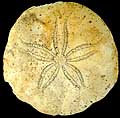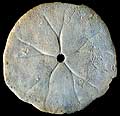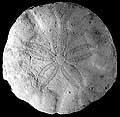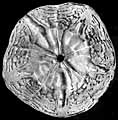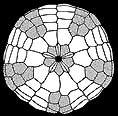The fossil S. tsudai (Morishita) illustrated here differs from the type species S. mirabilis Agassiz only in having more distally open petals. Very close to Remondella in having a marginal periproct, symmetrical petals and central apical disc and bifurcating food grooves, but differing from that genus in having a depressed central zone. It is more clearly different from Dendraster in having symmetrical petals and a marginal periproct.
Mortensen (1948) was not convinced that Scaphechinus could justifiably be separated from some species of Scutella (here treated as Parascutella), but Durham (1955) was able to show that in Scaphechinus the interambulacral zones are disjunct on the oral surface whereas in Parascutella they are just continuous. In other respects the two taxa are very similar.
The growth series of S. mirabilis was described by Nisiyama (1968). Small individuals have a supramarginal periproct and look remarkably like Kewia or Sinaechinocyamus
Agassiz, A. 1863. Synopsis of the echinoids collected by Dr W. Stimpson on the North Pacific Exploration Expedition under the commandant of Captains Ringold and Rodgers. Proceedings of the Academy of Natural Sciences, Philadelphia 15, 352-361.
J. W. Durham 1955. Classification of clypeasteroid echinoids. University of California Publications in Geological Sciences 31(4), 73-198.
Nisiyama, S. 1968. The echinoid fauna from Japan and adjacent regions. Part II. Palaeontological Society of Japan Special Papers 13, 1-491, pls 19-30.
Shigei, M. 1986. The echinoids of Sagami Bay Maruzen Co, Tokyo.
